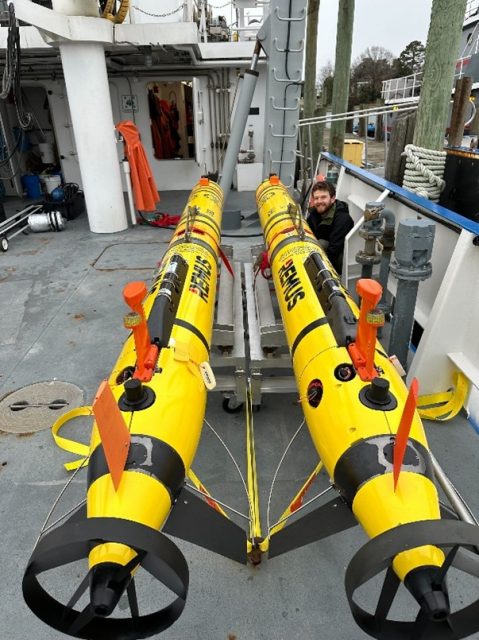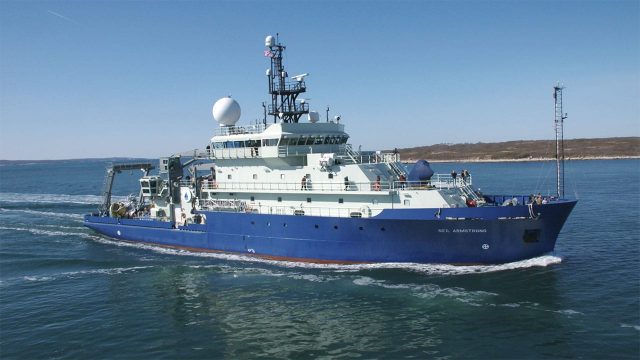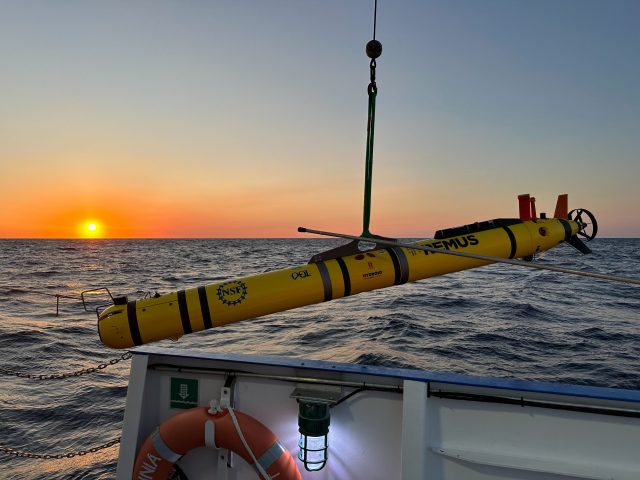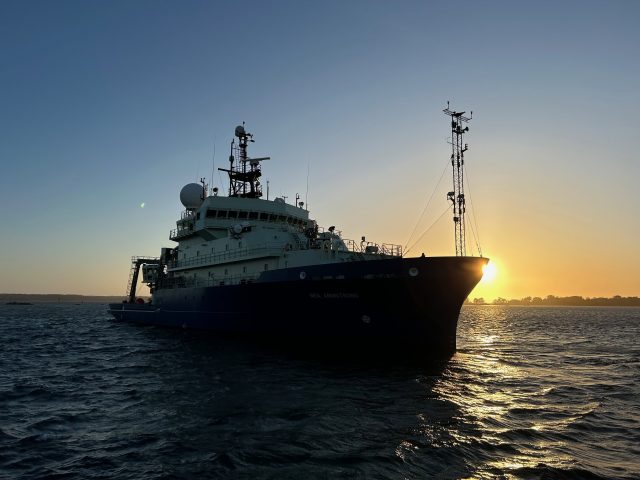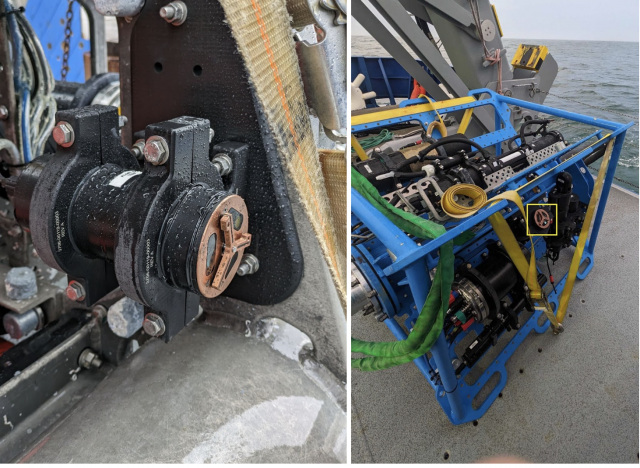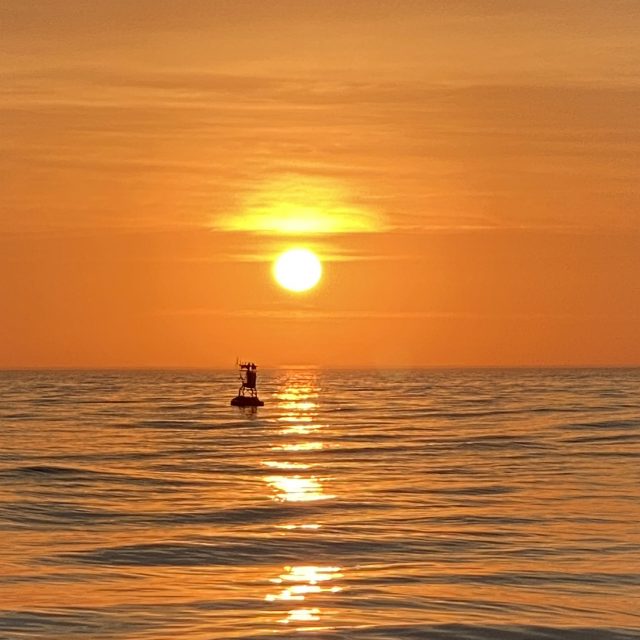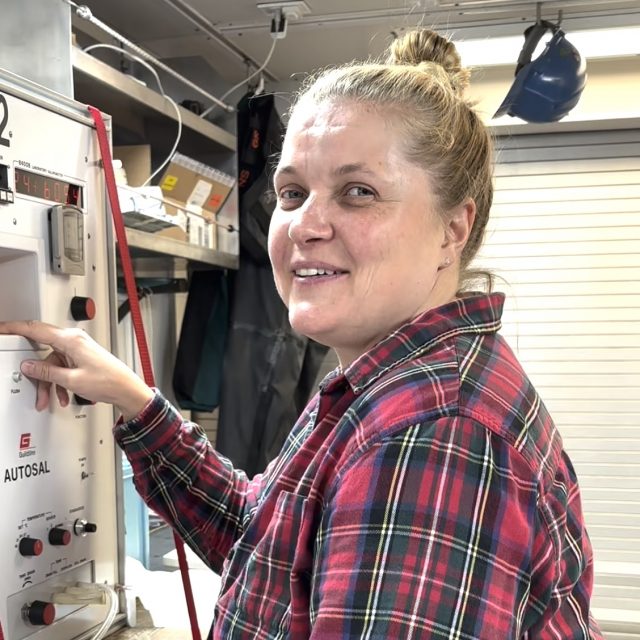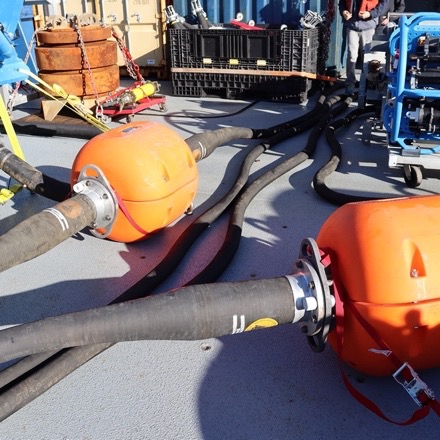Posts Tagged ‘Coastal Pioneer Array MAB’
Successful Underwater Surveys in the Mid-Atlantic Bight: OOI Team Deploys REMUS AUVs for Coastal Ocean Monitoring
Taking advantage of a period of calm weather, OOI staff successfully completed underwater surveys of the Pioneer Mid-Atlantic Bight (MAB) shelf and upper slope using OOI REMUS AUVs. With ab underway speed of over 3 knots, the AUVs provide synoptic transects of rapidly changing coastal systems – analogous to repeated “snapshots” of the ocean physical, biological, and nutrient conditions across the shelf capturing changes that occur over short time and spatial scales (meters to kilometers, and hours to one day).
The OOI Pioneer array was relocated from the New England Shelf (NES) to the southern Mid-Atlantic Bight in April 2024. AUV surveys previously conducted in the continental shelf waters offshore of New England now take place offshore of the sandy Outer Banks of North Carolina in a new and highly dynamic part of the US continental shelf. Moving the Pioneer Array to the MAB naturally resulted in some changes to operations, foremost being the use of new vessels (for this cruise, the R/V Virginia operated by the Virginia Institute of Marine Science). For efficiency, the AUVs are shipped fully assembled inside a 20 ft shipping container, along with all communications, control, and deck equipment. On arrival everything can be hoisted aboard and prepared for sea without needing re-integration that consumes valuable days on shore (Fig 1). The ships crane was modified by WHOI engineer Jared Schwartz to install the Ship of Opportunity Launch and Recovery System (SOO-LARS), a modular hydraulic winch system that OOI employs for safe and efficient deployment and recovery of these large AUVs on ships of several classes (Fig. 2).
The AUV operations at MAB derive from previous work at Pioneer NES. Once deployed, the AUVs run autonomously and sample in a series of saw-tooth profiles along a pre-programmed track, remaining in acoustic contact with the support vessel and surfacing periodically to update exact location from GPS. These plans were adapted for the MAB to compensate for the larger expanse of shelf traversed and the large changes in water column density between the shallow (25 m) inner shelf and deeper > 500 m upper slope. This is further complicated by density variations along the shelf and seasonally under the triple-influence of estuarine outflows, continental shelf processes, and the Gulf Stream just a few miles beyond the offshore extent of the sampling region (Fig 3). The MAB is also busy with a range of commercial, fishing, and military vessel traffic, offshore fixed installations, and ocean life in every shape and size imaginable. All factors that must be considered in advance and avoided underway by the invisible submerged AUVs. As was true for Pioneer NES, the support and knowledge of local vessel operators is vital to supporting at-sea operations and for meeting OOI’s science mission objectives.
The AUV data were offloaded from the vehicles after recovery. The data are discoverable in the OOI Data Explorer, and also available on the OOI raw data repository, following data format conversion and sensor post-calibration.
In addition to completing two consecutive surveys, each about 24 hours in length, the at-sea team of Andy Robinson, Collin Dobson, and Natalia Moore completed the scheduled recovery of the Offshore Mesoscale glider cp_379 (Fig. 4). A bonus accomplishment of this cruise was cross-training OOI staff new to AUV operations (Moore), made easier by the prevailing mild weather, experienced AUV techs, and the capable ship’s crew.
[gallery columns="2" size="large" ids="35942,35943,35944,35945"]Photo credits: Collin Dobson
Read MorePioneer 21 Cruise Cancellation
Due to unforeseen circumstances requiring shipyard repairs to the R/V Armstrong, it was not possible to conduct the fall service cruise for the Pioneer MAB Array, originally scheduled for December 2024. All array infrastructure remains in place and data are available via telemetry. The moorings will be refreshed during the spring 2025 cruise, currently scheduled for March 2025. Glider and AUV missions will continue to operate as normal.
Read MoreOOI-CGSN Team Completes First Standalone AUV Cruise at Pioneer MAB Array
The Ocean Observatories Initiative’s (OOI) Coastal and Global Scale Nodes (CGSN) team recently conducted their first standalone small vessel Autonomous Underwater Vehicle (AUV) cruise at the Pioneer Mid-Atlantic Bight (MAB) Array. Aboard the R/V Virginia, team members Andy Robinson, Collin Dobson, and Dan Bogorff successfully completed dock testing of their launch and recovery systems before heading offshore to carry out AUV transects through the array.
The mission utilized two REMUS600 AUVs, equipped with a variety of scientific instruments, including CTDs (conductivity, temperature, depth), fluorometers, dissolved oxygen sensors, nitrate sensors, photosynthetically active radiation (PAR) sensors, and ADCPs (acoustic doppler current profilers). These tools provide essential data for understanding ocean conditions and biogeochemical processes at the Pioneer MAB array.
This accomplishment highlights the OOI-CGSN team’s dedication to advancing autonomous AUV ocean exploration and data-driven research.
[gallery size="full" ids="34951,34952,34953,34954,34955,34956"](c): Collin Dobson
Read MoreConnecting Science and Community: Key Insights from the OOIFB Pioneer MAB Workshop
The Coastal Pioneer Southern Mid-Atlantic Bight (MAB) Array Community Workshop, held from September 10-12, 2024, at Old Dominion University, brought together a diverse group of scientists, educators, and stakeholders to explore the potential of the Pioneer MAB Array in advancing oceanographic research in the region. Funded by the U.S. National Science Foundation (NSF) and dedicated to the memory of Dr. Larry Atkinson, the event organized by the Ocean Observatories Initiative Facilities Board (OOIFB), aimed to highlight the array’s capabilities, evaluate regional research progress, and promote collaboration within the ocean research community.
Workshop Focus and Objectives
The workshop offered an in-depth exploration of the Pioneer MAB Array, showcasing its measurement capabilities and ability to improve our understanding of the Southern Mid-Atlantic Bight’s complex oceanographic processes. Participants reviewed past research, discussed data access, and assessed current knowledge and gaps in the region, guided by insights from local stakeholders to align research priorities with community needs.
Day 1: Setting the Stage for Collaborative Research
The first day began with a dedication to Dr. Larry Atkinson, whose career laid the groundwork for many oceanographic initiatives in the region. The morning sessions featured an overview of NSF funding opportunities, encouraging participants to propose innovative research projects using OOI data.
The OOI presentations showcased the successes of past research and outlined the proposal process for adding instruments to the array. These discussions set the stage for deeper dives into key science themes, such as the dynamics of shelf-slope exchange, biogeochemical cycling, and the impact of extreme events like hurricanes, winter storms and freshwater outflows.
The afternoon was dedicated to breakout sessions, where participants engaged in discussions on specific science themes. These sessions allowed for the exploration of collaborative research ideas and the identification of potential projects that could leverage the capabilities of the Pioneer MAB Array.
Day 2: Harnessing Data for Research and Innovation
The second day focused on data access and utilization, with hands-on demonstrations of the latest OOI data tools. Participants were introduced to the OOI Data Explorer and other data access methods that facilitate the retrieval and analysis of complex oceanographic data. These sessions also highlighted the program’s approach to data quality assurance and control, ensuring that researchers have access to reliable and accurate information.
Breakout sessions offered practical experience with data access through various platforms including Jupyter notebooks. These tools enable researchers to leverage the rich datasets provided by the Pioneer MAB Array for a wide range of projects, from studying physical oceanography and biogeochemistry to investigating ecosystem dynamics and the effects of extreme weather events.
The day concluded with a panel discussion on the use of modeling in interdisciplinary projects, providing insights into how data can be integrated into complex models to better understand ocean processes.
Day 3: Expanding Broader Impacts and Future Directions
The final day of the workshop shifted focus to the broader impacts of using OOI data in educational and community contexts. Panel discussions explored innovative ways to integrate OOI data into K-12 and higher education curriculums, as well as engaging citizen scientists and the fishing community in data collection and its many uses. These sessions highlighted the potential for data-driven outreach and education programs to inspire the next generation of oceanographers and to raise public awareness of ocean science.
Key Takeaways
The workshop highlighted the Pioneer MAB Array’s potential to advance our understanding of the Southern Mid-Atlantic Bight and emphasized the importance of accessible data for researchers, educators, and citizen scientists. It effectively fostered collaboration within the scientific community, paving the way for new research initiatives that will propel scientific progress in the region for years to come.
[caption id="attachment_34869" align="alignnone" width="640"]
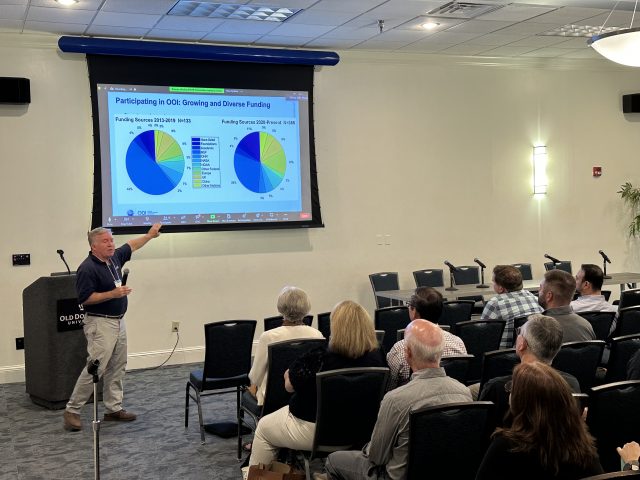 OOI Principal Investigator, James Edson[/caption]
[caption id="attachment_34866" align="alignnone" width="640"]
OOI Principal Investigator, James Edson[/caption]
[caption id="attachment_34866" align="alignnone" width="640"]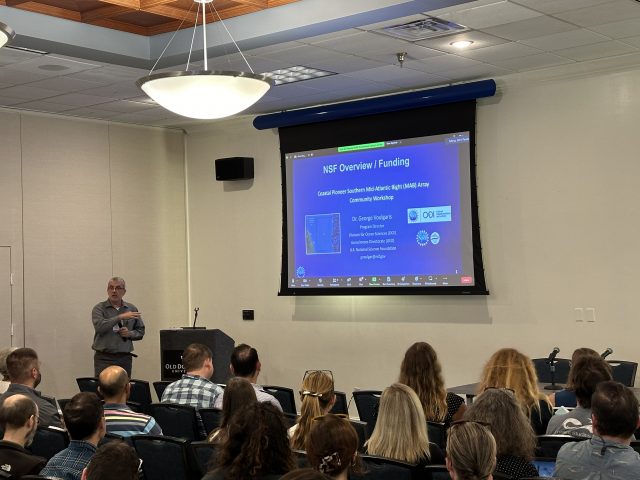 George Voulgaris, NSF OOI Program Director[/caption]
Read More
George Voulgaris, NSF OOI Program Director[/caption]
Read More Opportunity to Add New Sensors/Equipment to Pioneer MAB Array
The U.S National Science Foundation (NSF) Ocean Observatories Initiative (OOI) is excited to report that the relocation of the Pioneer Array to the Mid-Atlantic Bight (MAB) is now complete and the OOI facility is again considering requests by Principal Investigators to add new sensors and/or equipment to the Pioneer MAB Array. The process for requesting additions to the Array is described here.
The MAB deployment is the culmination of a three-year, multi-tiered process to relocate the Pioneer Array from its former location off the New England Shelf to the MAB. The NSF and the OOI Facilities Board (OOIFB) hosted a series of workshops in 2021 to elicit community input on where a relocated Pioneer Array might best meet science and educational needs. Based on input from these community workshops, the NSF gave its approval to the MAB site and the process was launched. Data from most instruments is available in real-time from the OOI Data Explorer. All non-telemetered data will be available after instruments are recovered on Array maintenance cruises that occur at nominal six-month intervals (April, October).
“Completing installation of the Pioneer Array in the MAB was the culmination of a significant effort by the OOI Team,” said Al Plueddemann, who served as the Chief Scientist for the first deployment of the array in the MAB and is Principal Investigator for OOI’s Coastal and Global Scale Nodes. “The time is right for researchers to propose additional sensors or equipment be added to the array so its full data collection potential can be realized.”
Notes:
- The installation of some sensors, especially acoustic sensors, may be subject to compliance with NSF’s Memorandum of Understanding with the US Navy.
- While the requests must be made for any additions to the Array, OOI would appreciate notification on plans to deploy stand-alone instrumentation within the OOI footprint.
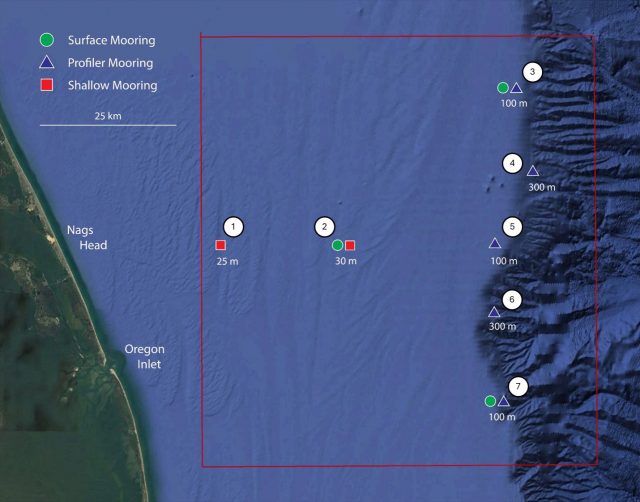 Pioneer MAB Layout[/caption]
Read More
Pioneer MAB Layout[/caption]
Read More Hot Wash: Pioneer-Adjacent PIES Deployments
RAPID: A Cost-Effective Approach for Characterizing Variability at High Temporal Resolution for Long Duration on the Continental Slope of the Southern Mid-Atlantic Bight
Two popeye data shuttle-enabled current and pressure sensor equipped inverted echo sounders (PDS-PIESs, Figure 1) were successfully deployed on the continental slope east of the U.S. National Science Foundation Ocean Observatories Initiative (OOI) Pioneer Array in the southern Mid-Atlantic Bight in June 2024. Data collected during the 4-year deployments will be shared broadly when PDS pods ascend annually to the sea surface and return data batches via a satellite link.
[media-caption path="https://oceanobservatories.org/wp-content/uploads/2024/06/IMG_8421-scaled.jpg" link="#"]Figure 1. Massachusetts Institute of Technology/Woods Hole Oceanographic Institution (MIT/WHOI) Joint Program students, Ysabel Wang (right, Physical Oceanography) and Will Harris (left, Applied Ocean Science and Engineering) and WHOI technician Brian Hogue (background) preparing a PDS-PIES for deployment. The instrument will measure round trip vertical acoustic travel time with bursts of 16 pings every 10 minutes and near-bottom pressure and current measurements every 30 minutes. The PDSs (orange) are scheduled to rise to the sea surface to return data batches remotely on September 1 in 2024 and yearly thereafter until 2027 with recovery of the PIES (white) planned for 2028.[/media-caption]The scientific motivation is to (1) capture mesoscale variability offshore of the Pioneer Array, (2) capture western excursions of the Gulf Stream North Wall that may influence ocean-shelf exchange, and (3) observe the upper portion of the equatorward-flowing Deep Western Boundary Current where it squeezes under the poleward flowing Gulf Stream. The PDS-PIESs were deployed on the 1000 m isobath 40-km apart to extend the Pioneer Array mooring footprint offshore and to allow comparison with a glider which is running a line (nominally) along the 1000 m isobath (Figure 2).
[media-caption path="https://oceanobservatories.org/wp-content/uploads/2024/06/Screenshot-2024-06-11-at-2.08.19-PM.png" link="#"]Figure 2. Map of PDS-PIESs (red dots, C1: 36° 3.125′ N; 74° 42.365′ W and C2: 35° 42.005′ N; 74° 46.209′ W), Pioneer moorings (yellow dots), and nominal offshore Pioneer glider line (blue). Red curve is time-averaged position of the Gulf Stream core and dotted lines are Jason altimeter tracks. Heavy contours are the 200 and 1000 m isobaths.[/media-caption]Cruise RR2407 was supported through the Office of Naval Research through the National Ocean Partnership Program Global Internal Wave (NGIW) study and provided at sea experiences for four MIT/WHOI Joint Program students and four undergraduates from the University of Massachusetts Dartmouth as part of their Blue Economy Program with WHOI. Many thanks to the National Science Foundation Division of Ocean Sciences for funding the PDS-PIES deployments and to engineer Erran Sousa from the University of Rhode Island who provided emergency shoreside support (on a Saturday!) to walk us through the PDS setups.
Read More
Pioneer MAB Providing Turbidity from OOI Core Fluorometers
OOI is now providing telemetered turbidity measurements from the Coastal Pioneer Mid-Atlantic Bight (MAB) Array using Sea-Bird Scientific ECO triplet-w optical sensors. A test deployment showed that these instruments measured turbidity consistent with co-located turbidity meters that were recommended at the scientific community workshops. The results of the test deployment confirmed that OOI could satisfy the request for turbidity data with re-purposed instruments already in the suite of OOI core sensors. OOI has used ECO triplet-w optical sensors to measure chlorophyll a, CDOM fluorescence, and optical backscatter. This April, ECO triplet sensors were deployed with a secondary calibration from the vendor to convert backscatter channel (700 nm wavelength) measurements to turbidity in Nephelometric Turbidity Units (NTUs).
[media-caption path="https://oceanobservatories.org/wp-content/uploads/2024/05/Screenshot-2024-05-30-at-4.33.23-PM.png" link="#"]Figure 1: Comparison of turbidity recorded during Coastal Pioneer MAB Array At-Sea Test 3 from a Seapoint turbidity meter and a Sea Bird ECO triplet optical sensor. Data shown was recorded in March 2023 at a depth of 35 m.[/media-caption]To conduct the test deployment, turbidity measurements were recorded every 15 or 30 minutes from 1-minute bursts of sampling at 1 sample per second (1 Hz) by both the ECO-triplet and co-located community-recommended turbidity meters. Turbidity in NTUs from the ECO triplet was calculated by applying a vendor-supplied scaling factor to the raw voltage counts minus the dark counts. The requested turbidity meters reported their measurements as a mean of the sample burst measurements, so the mean of each ECO triplet sample burst was computed for comparison. The burst means from ECO triplets were compared with the other turbidity meter measurements at the same location and depths. A time series comparison from 35 m depth during March 2023 showed a mean difference of 0.2 NTU between the two instruments. The standard deviation of the difference at 35 m depth was 1.2 NTU (Fig. 1). The March 2023 comparison at 7 m depth showed a mean difference of 0.1 NTU. The standard deviation of the difference at 7 m depth was 0.06 NTU. Turbidity measurements recorded before and after a CTD cast at the start of the test deployment were also within 0.15 NTUs of the mean turbidity measurements in the surface mixed layer and bottom layer from a rosette-mounted Wet Labs FLNTURTD. The full report on the test deployment, At-Sea Test 3, is available upon request. Based on the results of the test deployment, the OOI Program determined that the ECO triplet-w optical sensors with a secondary calibration could deliver good quality turbidity data.
ECO triplet optical sensors deployed as part of the Coastal Pioneer MAB Array now allow OOI to serve turbidity data from all 3 surface moorings at 7 m depth and 1 m above the seafloor. The use of existing OOI core sensors simplified integration into the instrument platforms, since additional ECO triplets only had to be added to seafloor nodes, and it streamlined the process of serving data, since existing sensor processing code could be reworked to provide turbidity data. Turbidity data delivered by OOI include all samples recorded during a sample burst so that data users can apply their preferred aggregation method. Since April, the ECO triplets on the near-surface platforms (Fig. 2, right) have been sampling at 1 Hz for bursts of 3 minutes four times an hour, and on the seafloor nodes (Fig. 2, left) the sensor samples at 1 Hz for 17 minutes once an hour. Data users can view telemetered turbidity data here: Coastal Pioneer MAB Array turbidity on Data Explorer.
[media-caption path="https://oceanobservatories.org/wp-content/uploads/2024/05/Screenshot-2024-05-30-at-4.32.51-PM.png" link="#"]Figure 2: Sea Bird ECO triplet optical sensors that are measuring turbidity are mounted on the Seafloor Multi-Function Node (left) and on the Near-Surface Instrument Frame (right, yellow box) of the Coastal Pioneer MAB Surface Moorings: Northern, Southern, and Central. The copper-covered “Y” is a wiper blade that prevents growth and marine debris from accumulating over the oval sensor windows. Credit: Sawyer Newman © WHOI. [/media-caption]
Read More
Pioneer Array Operational at MAB
A move is declared
Months of toil undertaken
This day it is done
Coastal and Global Scale Nodes (CGSN) Principal Investigator Al Plueddemann penned the haiku above in recognition of the successful installation of the Pioneer array at its new location in the Mid-Atlantic Bight (MAB) on April 17, 2024. This momentous occasion occurred on Haiku Wednesday, which prompted the poetic marking of a three-year effort to have the array deployed and telemetering data from the MAB.
The relocation of the Pioneer Array from its former location off the New England Shelf (NES) to its new location was a multi-tiered process. The National Science Foundation (NSF) joined forces with the Ocean Observatories Initiative Facility Board (OOFIB) to host a series of workshops in 2021 to elicit community input on where a relocated Pioneer Array might best meet science and educational needs. Based on input from these community workshops, the NSF gave its approval to the MAB site and the process was launched.
“Completing installation of the Pioneer Array in the MAB was the culmination of three years of preparation, which began with planning workshops in 2021, the recovery of the NES array in 2022, and engineering, procurement, and testing in 2023,” said Plueddemann, who also served as the Chief Scientist aboard the R/V Neil Armstrong for the first deployment of the array in the MAB. “It took an incredible effort from the whole CGSN Team to address all the considerations in moving the array to its new location. It is gratifying to see the successful deployment, with new, multidisciplinary data now available from this important oceanic region.”
[media-caption path="https://oceanobservatories.org/wp-content/uploads/2024/04/New-shallw.jpg" link="#"]Two newly designed shallow water moorings were deployed at the Pioneer MAB site. These specially designed moorings allow a wave-powered profiler to span the upper 80% of the water column in water depths as shallow as 25-30 m. Credit: Sawyer Newman © WHOI.[/media-caption]The primary objectives for the April cruise included installation of three surface moorings, five profiler moorings, and two newly designed shallow water moorings. The moorings create the backbone of MAB Array, a frontal-scale, T-shaped array located off the coast of Nags Head, North Carolina, starting ~25 km offshore and extending ~50 km east/west and ~50 km north/south across the continental shelf. The ten moorings occupy seven sites; three sites contain both a surface mooring and a profiler mooring. In order to provide synoptic, multi-scale observations of the outer shelf, shelf break, and continental slope, the moored array is supplemented by four gliders and two AUVs. The gliders operate for 45-90 days at a time, provide transects along and across the shelf, and monitor the mesoscale field of the slope sea. The AUVs are deployed and recovered from the ship over a ~24 hr period and provide synoptic across- and along-front “snap shots” of the frontal region.
[media-caption path="https://oceanobservatories.org/wp-content/uploads/2024/04/NESLETER.png" link="#"]Collaboration between OOI and the Northeast U.S. Shelf (NES) Long-Term Ecological Research (LTER) project began in 2017 and continued during this deployment expedition.Taylor Crockford was onboard to deploy an Imaging FlowCytobot (IFCB) that continuously sampled seawater while the Armstrong was underway. Shown here are some of the creatures living in the seawater along the route. Credit: Taylor Crockford © WHOI.[/media-caption]Once the deployment was in place, the team turned its attention to additional expedition objectives, including a bathymetry/sub-bottom survey of a potential alternate Western mooring site, and cross-shelf and along-shelf CTD (conductivity, temperature, and depth) transects. Once those were completed, the team headed home aboard the R/V Neil Armstrong to its home port in Woods Hole, MA where they were heartily greeted for a job well done.
[media-caption path="https://oceanobservatories.org/wp-content/uploads/2024/04/Sunrise-17-April-Ryder-2-scaled.jpg" link="#"]The sunrise was captured on 17 April over the Northern Offshore Surface buoy, highlighting the completion of the installation of the Pioneer Array in its new location in the Mid-Atlantic Bight. Credit: Jim Ryder © WHOI.[/media-caption]A review of the day-to-day operations to install the Pioneer Array in the Mid-Atlantic Bight m can be found here.
Read MoreAnd It’s a Wrap!
The Coastal Pioneer Array MAB team completed all the objectives of Leg 1 by the end of the day April 8th and started the transit home, back to the dock at Woods Hole. Taking advantage of a day in the wet lab, Glider Lead Diana Wickman took the opportunity to interview some folks about their experiences aboard the Armstrong over the last nine days. Hear what they have to say about the best parts of the journey.
Read MoreHoses Galore Hold Moorings Together
A flexible connection between the buoy and the anchor of the Coastal Surface Moorings of the Pioneer MAB Array is created by multiple hoses with the capacity to stretch while maintaining an electrical connection (Fig 1). The stretch is necessary to account for wind, waves and currents that push and pull the buoy relative to the anchor. The hoses connect mooring components and contain coiled conductors that allow data transfer and carry power generated by wind turbines and solar panels on the buoy.
The Northern Coastal Surface Mooring deployed for the first time in the MAB on April 4, 2024, illustrates the vital role these connection points play in keeping the mooring in place and operating. The mooring was deployed in 100 meters of water. The surface buoy is connected to the near surface instrument frame with a five-meter-long electromechanical chain (EM) chain. The EM Chain is flexible enough to bend to allow deployment (Fig. 2) but does not stretch. This provides support and stability at the top of the mooring. The EM chain also contains conductors to allow transmission of power created by solar, wind, and batteries on the surface mooring to the instruments below.
[media-caption path="https://oceanobservatories.org/wp-content/uploads/2024/04/EMChain.jpg" link="#"]Fig 2. The EM Chain connects the bottom of the surface buoy to the Near Surface Instrument Frame (NSIF) to left. Credit: DT Crist © WHOI.[/media-caption]Power moves through the EM chain to the instruments attached to the Near Surface Instrument Frame (NSIF), and then off to three stretch hoses each 30.48 meters long! The stretch hoses do what their name implies, stretch as needed in response to environmental conditions, yet they are strong enough to keep the mooring in place. The first section of stretch hose is connected to a Hose Interface Buoyancy (HIB) module, an orange flotation device that helps keep the stretch hoses floating and upright. The second section of stretch hose connects to a second HIB. Electrical connectivity is maintained by wired connections from the end of a stretch hose, through the hollow center of the HIB, and then to the next hose.
[media-caption path="https://oceanobservatories.org/wp-content/uploads/2024/04/HIBS.jpg" link="#"]Two Hose Interface Buoyancy (HIBs) sections are connected to each other with electromechanical stretch houses that provide flexibility and strength to the mooring and transmit power down the line. Credit: DT Crist © WHOI.[/media-caption]The third stretch hose section is connected to the Multi-Function Node (MFN), which houses instruments that need power. The MFN also contains the anchor.
[media-caption path="https://oceanobservatories.org/wp-content/uploads/2024/04/MFN.png" link="#"]The Multi-Function Node and Anchor Assembly being deployed off the back deck of the R/V Neil Armstrong. The stretch hose, which connects it to the rest of the mooring, is at the top and to the right. Credit: DT Crist © WHOI.[/media-caption]
[media-caption path="https://oceanobservatories.org/wp-content/uploads/2024/04/Complete-configuration.jpg" link="#"]More than 96 meters of hose keep the Coastal Pioneer Northern Array in place in its new location in the Mid-Atlantic Bight. Credit: DT Crist © WHOI.[/media-caption]
Perspective in Pounds
What’s amazing about the hoses that keep the Pioneer moorings on station and operational is the scale of the equipment that makes up the mooring. Take the top and the bottom of the mooring, for example. The Surface Buoy weighs some 8,500 pounds. The MFN and Anchor Assembly weigh 11,000 pounds. These weights and the scale of the equipment are not only challenging for moving around the deck and getting into the water, but thanks to the hoses these massive components are able to stay in the water, collect data, and report for up to six months. Hats off to hoses galore!
Read More

